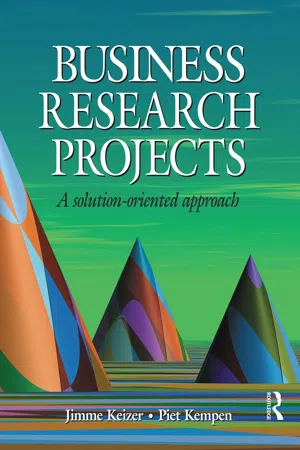
- 256 pages
- English
- ePUB (mobile friendly)
- Available on iOS & Android
Business Research Projects
About This Book
Almost all higher educational institutions have built some kind of fieldwork project into the advanced stages of their programmes and the research project should integrate theory, practice, knowledge and skills.Students should be able to apply their acquired knowledge and understanding in a manner that indicates a professional approach to their work or vocation, and have the ability to integrate knowledge and handle complexity, and formulate judgements with incomplete or limited information. It is important that they can communicate their conclusions and the knowledge and rationale underpinning these to specialist and non-specialist audiences clearly and unambiguously.Business Research Projects offers the reader a comprehensive framework for going through the successive process steps of the fieldwork project. There is a logbook which provides for each of the ten steps a checklist enabling students to document the progress of their projects and communicate about the project with their coaches and supervisors.Successful projects require specific process knowledge and skills: • Recognition and description of an organisational problem.
• Design and organisation of a research project.
• Communication with people on different levels within the organisation.
• Interviewing, listening, negotiating, giving presentations, persuading people.
• Project management.
• Developing solutions in collaboration with people in the organisation.
• Implementation of accepted solutions.
Frequently asked questions
Information
Part 1 Model of a fieldwork project
Introduction to Part 1
- The company formulates an assignment
- The student studies the causes and backgrounds, develops proposals and contributes to the implementation of these proposals.
- Implementation forms an explicit part of the fieldwork project
- Much attention is paid to the start of the project – the first phase comprises no less than six of the ten steps
- Much attention is paid to obtaining support for the solution that will be developed.
Chapter 1 The fieldwork project as a consulting process
Graduating and consultancy
- Recognize and describe a problem
- Organize the research
- Communicate with people from different levels in the organization
- Hold interviews, give presentations, listen to, negotiate with and convince people
- Independently set up a fieldwork project and carry it out according to plan
- Come up with solutions in co-operation with people from the organization
- Implement the accepted solutions.
- The fieldwork project is divided into ten steps (Ten-Step Plan, TSP)
- A step-by-step description of the necessary activities and the desired/intended end product is provided
- A checklist is given at the end of each step, to determine whether the intended objective of this step has been achieved
- A number of small cases are included to help put the knowledge acquired in this book into practice.
Effective consulting
- It should be problem directed
- It should be environment directed
- It should be change directed
- Open contracting is preferable
- Conscious positioning is required
- It should be coherent
- It should contain state-of-the-art knowledge.
Problem directed
External orientation
- High turnover and profit
- Low costs
- High customer orientation
- Good service
- High delivery reliability...
Table of contents
- Cover Page
- Half Title Page
- Title Page
- Copyright Page
- Table Of Contents
- Preface
- About the authors
- Part 1 Model of a fieldwork project
- Part 2 The Ten-Step Plan
- Part 3 Divergent scenarios
- References
- Index